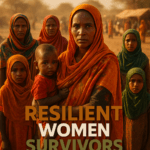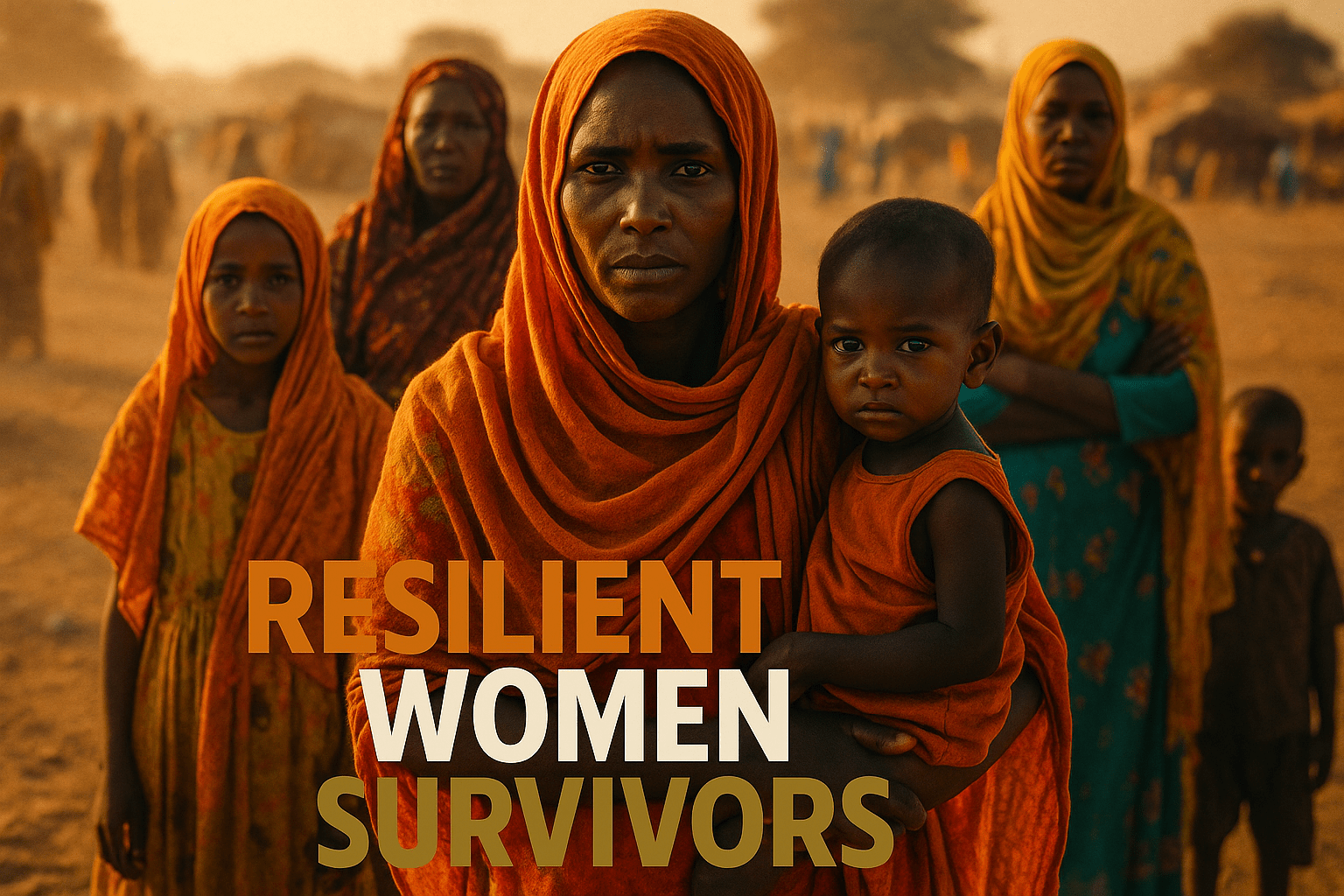

Sudan's Hunger Crisis: Women Starve Faster
By Darius Spearman (africanelements)
Support African Elements at patreon.com/africanelements and hear recent news in a single playlist. Additionally, you can gain early access to ad-free video content.
Sudan's Crisis: A Gendered Catastrophe
The food crisis in Sudan is a deepening tragedy, disproportionately affecting women and girls. New findings reveal that female-headed households (FHHs) are three times more likely to experience food insecurity than those led by men (IPS News). This stark disparity highlights a critical gender emergency, not merely a food shortage, driven by a lack of gender-responsive action (IPS News).
Of the 30.4 million people in Sudan needing food assistance, 15.3 million are women and girls (IPS News). The ongoing civil war has led to an increase in women leading households, often due to the death, disappearance, or displacement of men (IPS News). This makes simply living in an FHH a statistical indicator of hunger (IPS News). Only 1.9 percent of FHHs are food secure, compared to 5.9 percent of male-headed households (MHHs) (IPS News). Furthermore, 45 percent of FHHs reported poor food consumption, nearly double the rate of MHHs at 25.7 percent (IPS News). Only one-third of FHHs have an acceptable diet, compared to half of MHHs (IPS News). Nationally, 73.7 percent of women are not meeting the minimum dietary diversity, which severely impacts maternal and child health (IPS News). The rates of poor food consumption in FHHs have doubled in just one year, signaling a worsening crisis (IPS News). Nearly 15 percent of FHHs are living at or near famine thresholds, compared to 7 percent of MHHs (IPS News). A recent report also highlighted that women-led households are three times more likely to experience severe insecurity than those led by men (news.un.org).
Understanding Food Insecurity Terms
To fully grasp the severity of the crisis, it is important to understand the technical terms used to describe food insecurity. IPC4 refers to Integrated Food Security Phase Classification level 4, which indicates an emergency level of hunger (ipcinfo.org). Famine thresholds are strict criteria that must be met for a famine to be officially declared (csis.org). Acute food insecurity describes any severe lack of food at a given time (news.un.org). These classifications help humanitarian organizations assess and respond to crises.
The “lean season” is another critical concept. This is the period when food stocks from the previous harvest are depleted, and the next harvest is not yet ready (ipcinfo.org). During this time, food prices typically increase, and availability decreases, leading to a worsening of hunger and malnutrition, especially for vulnerable populations (ipcinfo.org). The current projections for food insecurity in Sudan from October 2024 to May 2025 inherently consider these seasonal variations (ipcinfo.org).
Food Insecurity Levels in Sudan
Conflict's Grip: Starvation in El Fasher
The escalating conflict, particularly in areas like El Fasher, is intensifying the humanitarian crisis and increasing the risk of starvation (wfp.org). At least 1.7 million people in Darfur are already experiencing emergency levels of hunger, classified as IPC4 (wfp.org). El Fasher, once considered a relatively safe haven, is now under siege, forcing many residents to flee multiple times (wfp.org).
As the lean season progresses and food supplies dwindle, hunger is expected to rise dramatically (wfp.org). Reports from besieged El Fasher indicate that people are resorting to eating charcoal and leaves to survive (bbc.com, news.sky.com). Food prices in El Fasher are four times higher than in other parts of the country (news.un.org). Aid trucks have not reached the region, and El Fasher remains under siege, exacerbating the dire situation (news.un.org).
Obstacles to Aid Delivery
Aid delivery in Sudan faces significant challenges due to funding shortfalls, logistical hurdles, and the ongoing conflict (IPS News). The World Food Programme (WFP) has scaled assistance to nearly 4 million people per month, but a staggering 26 million people remain in need (IPS News). Due to these circumstances, WFP has been forced to shrink assistance packages, reduce the number of recipients, and in some cases, cut off all assistance entirely (IPS News).
Sudan's vast size, lack of infrastructure, and challenging terrain, including deserts and impassable roads during the rainy season, severely hinder supply chains (IPS News). The conflict has disrupted trade routes, limiting supplies in besieged cities like El Fasher and Kadugli (IPS News). WFP urgently needs guarantees of safe passage to deliver supplies to critical locations (IPS News). Safe passage guarantees entail assurances from all warring parties that humanitarian aid workers and supplies can move freely and securely through conflict zones without interference, attack, or diversion (reuters.com). These guarantees must be provided by the governments and all armed groups involved in the conflict (reuters.com). Unfortunately, warring parties in Sudan often block crucial aid providers, including the WFP, from delivering food, demonstrating a lack of respect for humanitarian principles and international law (reuters.com).
The Vital Role of Women-Led Organizations
Women-led organizations (WLOs) are crucial in delivering aid but face severe underfunding and operational constraints (IPS News). These organizations are often the “backbone of response” in many areas, accessing regions where international systems cannot reach (IPS News). WLOs provide vital services such as solarizing clinics, conducting nutrition outreach, offering maternal healthcare, operating informal shelters, managing protection hotlines, and distributing food (IPS News). Many of these WLOs operate without institutional funding (IPS News).
UN Women supports 45 WLOs, but underfunding remains a critical issue (IPS News). Due to funding deficits, one WLO operating across eight states was forced to shut down 35 of its 60 food kitchens (IPS News). WLOs receive less than 2 percent of humanitarian aid funds (IPS News). These organizations are critical because they often have deep community ties, a nuanced understanding of local needs and cultural contexts, and can reach vulnerable women and girls who might be overlooked by larger aid organizations (reuters.com).
Humanitarian Aid Funding for WLOs
Magnified Inequalities and Harmful Coping Mechanisms
The conflict has magnified existing gender inequalities, leading to increased vulnerability and harmful coping mechanisms for women and girls (IPS News). Even before the conflict, women and girls faced challenges in accessing their rights due to cultural norms and traditional practices (IPS News). These norms can include restrictions on women's mobility, access to education, ownership of property, participation in public life, and decision-making within the household. In a crisis, these norms can exacerbate women's vulnerability by limiting their ability to seek aid, protect themselves from violence, or access resources for their families (ipcinfo.org).
Women are largely excluded from decision-making spaces, leading to their specific needs being overlooked (IPS News). The desperate search for food has led to an increase in harmful coping mechanisms, including child marriage, sexual exploitation, female genital mutilation, and child labor (IPS News). Since April 2023, 1,138 cases of rape have been recorded, including 193 children, with actual numbers likely much higher due to underreporting (IPS News). The number of people at risk of gender-based violence has tripled to 12.1 million in less than two years (unwomen.org). Conflict-related sexual violence is systematically used as a weapon of war (unwomen.org). Gender-Based Violence (GBV) encompasses harmful acts directed at an individual based on their gender, including physical, sexual, psychological, and economic violence (csis.org). Conflict-related sexual violence is a specific form of GBV used as a tactic of war, including rape, sexual slavery, forced prostitution, and forced pregnancy (csis.org). These forms of violence exacerbate food crises by displacing populations, destroying livelihoods, limiting access to aid, and causing severe physical and psychological trauma, particularly for women and girls (csis.org).
Impact on Children and Maternal Health
Malnutrition has devastating and distinct health outcomes for children and maternal health. For children, it can lead to stunted growth, wasting (severe low weight for height), weakened immune systems, increased susceptibility to infectious diseases, and impaired cognitive development (ipcinfo.org). For pregnant and lactating women, malnutrition can result in anemia, increased risk of complications during childbirth, low birth weight babies, and reduced ability to breastfeed effectively (ipcinfo.org). Children are particularly vulnerable due to their rapid growth and developing immune systems, while mothers' nutritional status directly impacts the health of their offspring (ipcinfo.org).
The crisis in Sudan is not confined to Darfur and El Fasher. The IPC report provides an analysis for the entire country, indicating that food insecurity is a nationwide issue (ipcinfo.org). The UN's “hunger hotspots” report notes that a projected further rise of returnees and refugees from Sudan is likely to increase acute food insecurity among both new arrivals and host communities in South Sudan, indicating widespread displacement from various parts of Sudan (news.un.org). The need for food security and nutrition surveys in unassessed areas of greatest concern, including greater Khartoum and Al Jazirah, in addition to areas already identified in Famine or at risk of Famine, further suggests a wider geographic concern (ipcinfo.org).
Urgent Actions for a Gender-Responsive Response
Urgent, gender-responsive actions are needed to address the crisis and prevent further starvation among women and girls (IPS News). UN Women recommends prioritizing food distribution and assistance planning for FHHs (IPS News). Establishing localized distribution sites can reduce movement-related risks for women (IPS News). Increased representation, at least 40 percent, of women in local aid committees and decision-making spaces is crucial (IPS News).
Increased investment and funding for WLOs are vital (IPS News). The international response involves a network of actors, including United Nations agencies, non-governmental aid groups, and Western donor countries, led by the United States (reuters.com). However, significant barriers exist to increasing aid, including the blocking of aid by governments and warring parties (reuters.com). While famine declarations can draw global scrutiny, there is little evidence supporting a significant relationship between declarations and increased international funding, and government resistance often hinders declarations themselves (csis.org).
Humanitarian Aid Reach in Sudan
ABOUT THE AUTHOR
Darius Spearman has been a professor of Black Studies at San Diego City College since 2007. He is the author of several books, including Between The Color Lines: A History of African Americans on the California Frontier Through 1890. You can visit Darius online at africanelements.org.
